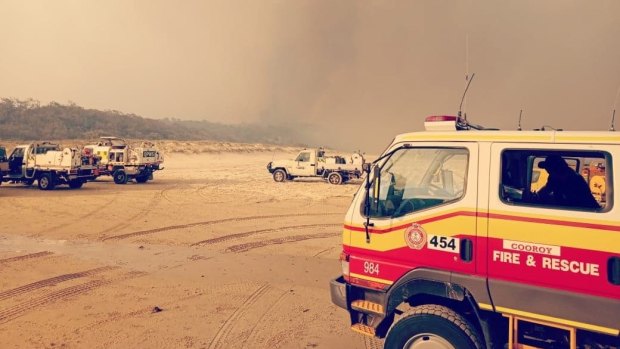This was published 4 years ago
Editorial
A stark reminder of bushfire danger
The enormous economic and health crisis brought on by the pandemic may have overshadowed the tragedy of last season's bushfires, but the recent spate of hot weather is a reminder of the potential dangers Australia faces again this summer.
Spring was a scorcher. Based on minimum and mean temperatures, it was the hottest seasonal lead-up to summer on record. And the month of November topped that record-breaking run; maximum, minimum and mean temperatures all exceeded previous highs. What also stands out is that these records were broken at a time when a La Nina weather event is under way in the Pacific. This usually brings cooler and wetter weather.

Firefighters have been trying to contain a bushfire on Fraser Island for weeks. Credit: Queensland Fire and Emergency Services
The hot spell has already had an impact. For more than six weeks a bushfire has razed almost half of the World Heritage-listed Fraser Island in Queensland. In NSW, more than 600 firefighters and water-bombing aircraft were involved in battling at least 200 blazes last weekend.
Let us hope this is not an early sign of things to come, but that would be an optimistic view. The findings from this year's royal commission into natural disasters offered a sobering assessment. Led by former air chief marshall Mark Binskin, it stated: "Extreme weather has already become more frequent and intense because of climate change. Floods and bushfires are expected to become more frequent and more intense."
For all the extra resources being harnessed to combat bushfires, the commission had this warning: "Catastrophic fire conditions may render traditional bushfire prediction models and firefighting techniques less effective."
The threat of climate change exacerbating natural disasters was backed up by the latest State of the Climate report, published last month by the Bureau of Meteorology and the CSIRO. It revealed that the frequency of the most dangerous 10 per cent of fire weather days has increased significantly in recent decades across many regions of Australia, especially in the south and east, due to the climate changing.
There was some hope that the catastrophic fires of last season – which killed 33 people, affected the health of many thousands, destroyed more than 3000 homes and caused $10 billion in damages – would finally trigger more substantial action on climate change from the Coalition government, but that may be wishful thinking, despite some recent shifts in rhetoric.
There is still much work to do. The royal commission put on the table extensive recommendations on the need for creating stronger peak agencies, better warning systems, faster military deployments and improved communication and co-ordination between all levels of government. These are essential reforms that should be carried out post-haste.
State governments do carry the greatest burden when it comes to fighting bushfires, but with the increased threat over a longer period spanning multiple states, the role of the federal government in managing and resourcing efforts to combat blazes will become more and more important. It is a welcome sign that new laws to declare a national state of emergency will go before Federal Parliament within days.
With a new fire season upon us, and the royal commission's recommendations made public, there need to be public assurances from our governments that everything that can and should be done to prepare is in train. Containing the pandemic has held the attention of all governments for most of this year. But with the worst of the outbreaks hopefully behind us, there should now be the capacity to ensure that in the event of another demanding bushfire season the systems and resources are in place to spare us a sequel to last season's disaster.
Note from the Editor
The Age's editor, Gay Alcorn, writes an exclusive newsletter for subscribers on the week's most important stories and issues. Sign up here to receive it every Friday.